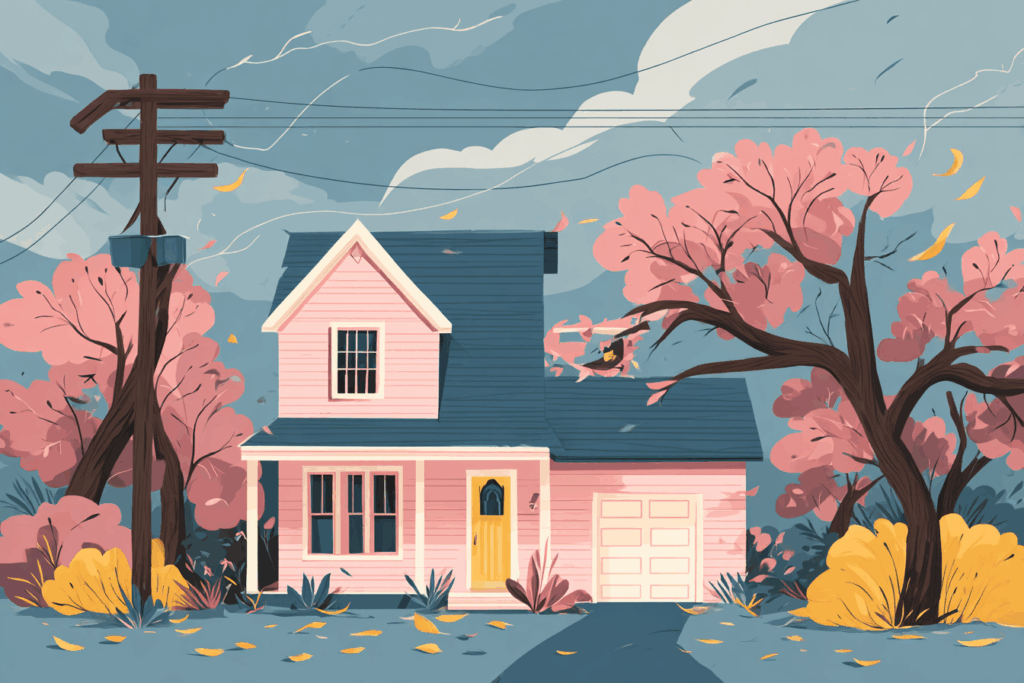Seasonal changes can quietly wear down your home. Every season has its own risks. If you don’t act, small problems can become expensive repairs. The best defense is a year-round home maintenance plan. It should fit the needs of each season. Here’s how to protect your home from seasonal damage with practical, effective measures.
Spring: Control Moisture and Prep for Growth
Spring introduces moisture, thawing, and plant growth. You need to inspect and reinforce areas vulnerable to water intrusion and overgrowth.
1. Inspect and Clean Gutters
- Remove leaves and debris from gutters and downspouts
- Ensure water drains away from your foundation
- Add splash blocks or extensions to move water away from the foundation
- Install downspout extenders if water pools near your home
These steps are core moisture-control principles that prevent mold and structural damage.
2. Check for Roof Damage
- Look for missing or cracked shingles
- Inspect flashing around vents and chimneys
- Hire a professional if you notice sagging or soft spots
3. Examine Foundation and Basement
- Check basement walls for cracks or signs of leaks
- Seal any minor foundation cracks with waterproof masonry sealant
- Install a sump pump or test your existing one
Find your Base Flood Elevation (BFE). Raise utilities when possible. If you have a basement, install backflow valves or sump pumps with battery backup. Make sure all of your belongings are documented for insurance purposes.
4. Service HVAC System
- Replace filters
- Schedule a spring tune-up for the air conditioning
- Clean vents and registers to improve airflow
Clear vegetation 2–3 feet around the outdoor unit. Flush the condensate drain. Also, swap in a fresh filter before the first heat wave.
5. Prune Trees and Shrubs
- Cut back branches that overhang your roof or power lines
- Remove dead limbs that could fall during storms
- Keep landscaping from touching the siding to prevent pests
6. Look for Pest Entry Points
- Seal cracks around windows, doors, and the foundation
- Use weatherstripping and caulk where needed
- Consider a professional pest inspection if you live in a termite-prone area
Spring moisture is the root cause behind many summer mold and foundation issues. Caring for your runoff and roof now can prevent musty basements and expensive repairs later.
Summer: Guard Against Heat and Storms

Heat, humidity, and summer storms can strain systems and structures. Your focus should be on ventilation, insulation, and weather protection.
1. Check Attic Ventilation and Insulation
- Inspect insulation for signs of pests or moisture
- Ensure attic vents are unblocked to prevent heat buildup
- Install a solar-powered attic fan if needed
2. Protect Against Power Surges
- Use surge protectors for electronics and appliances
- Consider installing a whole-home surge protector
Lightning can travel through wiring and damage electronics. A whole-house surge protector, along with point-of-use strips, offers strong protection. So, avoid using plugged-in appliances during storms.
3. Inspect Windows and Doors
- Test for drafts or poor seals
- Re-caulk and install weatherstripping as needed
- Use light-colored curtains or solar shades to reflect heat
4. Maintain the Lawn and Drainage
- Keep your lawn graded to drain water away from your foundation
- Clean storm drains near your property
- Test your irrigation system for leaks or broken heads
5. Prepare for Severe Weather
- Trim trees near power lines or your roof
- Anchor outdoor furniture and grills during storm warnings
- Check your home insurance policy for wind and hail coverage
Keep a defensible space of about 30 feet around your home. This area should be clear of leaves, needles, and anything flammable. Keep a hose that reaches the property perimeter and a cleanable room with a portable air cleaner for smoke days.
6. Monitor for Mold
- Use dehumidifiers in damp rooms like basements
- Inspect behind appliances and under sinks
- Ventilate bathrooms and kitchens regularly
Summer loss events are dominated by wind, hail, wildfire, and water intrusion. Hardening the “roof-to-ground” path—and adding surge protection—dramatically cuts risk.
Fall: Prepare for Cold and Falling Leaves
Fall is the best time to prepare for winter. You need to insulate, seal, and clear areas that will be affected by freezing temperatures and fallen foliage.
1. Clean Gutters Again
- Remove fallen leaves before they clog the drainage system
- Check for signs of rust or sagging
- Ensure downspouts still direct water away properly
2. Inspect and Service the Heating System
- Schedule a furnace inspection and cleaning
- Replace filters before turning on the heat for the season
- Bleed radiators if you use hot water heating
Service your furnace/boiler and replace filters. If you burn wood, schedule an annual chimney inspection/cleaning to reduce creosote and fire risk.
3. Winterize Exterior Plumbing
- Drain outdoor faucets and sprinkler systems
- Disconnect hoses and use insulated faucet covers
- Shut off outdoor water lines at the source if possible
4. Seal Exterior Cracks and Gaps
- Look for gaps around pipes, vents, and electrical boxes
- Use silicone or foam sealant to close gaps and prevent heat loss
- Check weatherstripping on garage doors
Air leaks drive heat loss and condensation in cold months. Caulk/weatherstrip doors and windows, seal attic penetrations, and top up insulation where needed.
5. Inspect the Roof and Chimney
- Check for loose shingles and damaged flashing
- Clean and inspect the chimney if you use a fireplace
- Install a chimney cap to keep animals and debris out
Repair loose shingles/flashings and clean gutters/downspouts one last time after leaves drop. Good roof drainage is your best defense against winter leaks and ice-dam trouble.
6. Test Smoke and Carbon Monoxide Detectors
- Replace batteries
- Test all units before turning on heat sources
- Install detectors on every floor, especially near bedrooms
Winter: Prevent Freezing and Ice Damage
Winter weather causes the most serious damage if you’re not prepared. Focus on keeping warmth in, water out, and pipes protected.
1. Prevent Frozen Pipes
- Insulate exposed pipes in basements, attics, and crawlspaces
- Let faucets drip during deep freezes to prevent pressure buildup
- Open cabinet doors under sinks to let warm air circulate
On the coldest nights, open sink-cabinet doors and let faucets drip (especially on exterior walls). Know your main shutoff valve and use it if a pipe bursts.
2. Manage Ice Dams
- Keep the attic cold with proper insulation and ventilation
- Use roof heat cables if ice dams are a recurring problem
- Remove snow from the roof edges using a roof rake
After heavy snow, safely remove excess from low-slope roofs and keep intake/exhaust vents clear (dryer, furnace, bath). Ice-dam prevention starts with fall air sealing/attic insulation; avoid hacking at ice, which can damage shingles.
3. Keep Walkways Safe
- Use ice melt on driveways and stairs to prevent slips
- Fix cracked concrete before snow and ice worsen it
- Clear snow regularly to avoid buildup and water seepage
4. Watch for Ice Around the Foundation
- Shovel snow away from your home’s perimeter
- Clear pathways for melting water to flow away
- Check the basement for signs of moisture or frost
5. Use a Backup Heat Source
- Keep a space heater or fireplace in case of power loss
- Never use ovens or grills for indoor heating
- Stock up on fuel or batteries in case of an emergency
Prepare for outages with flashlights, batteries, and charged power banks. Never run generators indoors or in attached garages; ensure CO alarms have fresh batteries.
6. Inspect the Roof from the Ground
- Look for sagging, heavy snow buildup, or fallen branches
- Address problems quickly before freeze-thaw cycles cause leaks
Winter insurance claims mainly come from frozen pipes and leaky roofs. You can prevent these issues with some simple preparation and careful monitoring during cold weather.
Year-Round Tips
Some steps protect your home in every season. Build these habits into your monthly or quarterly routine.
1. Review Your Home Insurance
- Ensure coverage matches seasonal risks in your area
- Update policies if you’ve added new structures or systems
2. Keep Emergency Supplies Stocked
- Flashlights, batteries, water, non-perishables, and a first aid kit
- Backup power banks for phones
- Fire extinguisher in the kitchen and garage
3. Install Smoke Alarms
- Install or check batteries in every bedroom
- Make sure there is an alarm on each level
- Test monthly and replace units after 10 years
- Add CO alarms
4. Create a Maintenance Calendar
- Schedule seasonal inspections
- Set reminders for HVAC service, gutter cleaning, and sealing
- Document maintenance to track issues over time
Conclusion
Preventive maintenance saves time, money, and stress. Each season brings unique risks to your home. But with a simple checklist and a proactive mindset, you can lower the chances of damage all year. Stay ahead of the weather. Your home will last longer, perform better, and stay safer with regular care.
You might also be interested in: Seasonal Roof Maintenance: Year-Round Best Practices




